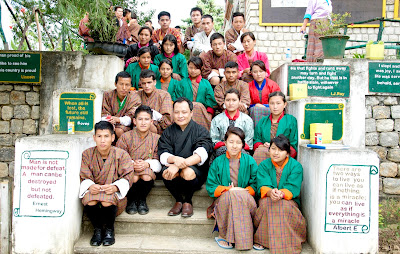The tall notice (order) came. And
the gate of Samdrupjongkhar was closed, sturdily. Not a single Bhutanese
vehicle was allowed to go outside the gate. Not a single Bhutanese soul was
allowed to walk out.
The notice stated the highway of
Assam would be affected, as there would be a strike in the neighboring Indian
State. So, the Bhutanese commuters were restricted to travel through the State.
Thus, I returned to my hotel room.
It was frustrating to stay in a place one more day, or more, where I didn’t know
a soul and of the place I was not familiar.
It’s a thing of Samdrupjongkhar, a small town of about 10,000 inhabitants at the southeastern part of Bhutan that borders the Indian State of Assam. It is often used as an entry and exit point by the merchants and commuters travelling to eastern Bhutan. In fact, it is a one-night halt town. But due to unending insurgency issues and protests in Assam that affect the highway, travellers are often stranded in this town, sometimes up to three days.
It’s a thing of Samdrupjongkhar, a small town of about 10,000 inhabitants at the southeastern part of Bhutan that borders the Indian State of Assam. It is often used as an entry and exit point by the merchants and commuters travelling to eastern Bhutan. In fact, it is a one-night halt town. But due to unending insurgency issues and protests in Assam that affect the highway, travellers are often stranded in this town, sometimes up to three days.
So instead of staying of staying in my
room grumbling about the situation, I decided to walk around and explore the
town more. To kill my time. And to escape from boredom. Surprisingly, I found
the town fascinating and it has so much to offer, in its own little ways though.
Some of my findings and recommendations that you can do in case you are
stranded in this town in the future are:
Mani dungkar
Mani dungkar
Right in the middle of town is a small park with a beautiful dungkar of Bhutanese architectural
design and intricate paintings. It has some open space, where green trees and
flowers provide you shade. You can either sit on the concrete benches and relax
or just lie down on green meadows and enjoy children playing around or just
watch the dungkar glitters at night,
as the lights fall on it.
The Gate
One thing I loved doing in Samdrupjonkhar to pass my time is going to
the border gate, and just sit, watch. So many Indians, over a thousand, mostly
day laborers enter the gate in the morning. They come riding bicycles. But
before entering, they keep their cycles locked outside the gate in a long line.
They religiously go for security check, register their names at the immigration
counter and march towards their respective works.
In the evening, 5 pm onward, the laborers return. Though muddied with
dust and sweats, their face glimmer with smile and joy. Some bursting into
laughter and others engage in a loud happy talk; for they could earn their
day’s wages and are happy to feed their families. They pick up their cycles and
ride off home. This particularly sight brings me such a beautiful feeling - of
simplicity and naivety, of hard work and rewards, and of reverence and beauty
of life.
The Town
Strolling around the town helps you spend your time. But do it slowly,
because the town is very small. A bustling and clean town, Samdrupjongkhar is
the main economic centre of the eastern Bhutan. It holds the distinct honour of
being the oldest town in Bhutan, and is believed to be developed as a result of
construction of the Samdrupjongkhar-Trashigang national highway in the 1960s.
As you walk around it, you get to see a diverse mixture of small shops,
hotels, bars and restaurants. Not only the locals, but also people from as far
as Trashigang, Lhuentse and Yangtse are seen in the town trading. It’s intriguing
to see them carrying loads of goods on their back staggering and bargaining and
buying more.
However, what I liked most about the town is to read funny names of the
shops. Some are very hilarious. |
| Pholang Katang Hotel & Bar |
Accommodation
and foods
Today, there are a handful of well-maintained
hotels with good logistics. They even serve you a good mix of Bhutanese, continental
and Indian cuisines. Hotel Menjong, Hotel Friends and Hotel Park are a few
to name.
But the Hotel Friends is very popular among the locals and even
tourists from India for its foods, whiskeys and beers. Kuenzung Pizza and
Restaurant, a newest hangout place in the town, is also popular among the
locals that serves pizzas, cakes and noodles.
Entertainment
I was told that Samdrupjongkhar used to
house the oldest cinema theatre in the country, which was popular even among
the Assamese. However, today, it seems defunct.
But other forms of
entertainment have emerged in the town, such as drayang and karaoke. They are
located in the Lower Market and always gather huge crowds at night.
Suspension bridge
Right next to the Lower Market, there’s a tall and long suspension
bridge over a river that connects a housing colony to the town. When I visited
it, I spotted many young people and Indian tourists taking pictures and enjoying
the beautiful sight and pleasant breeze.
Youth Centre
Two minutes walk towards north of the town, in front of the Bus
Station, you can spot a Youth Center. It’s a cozy place that provides services
like Internet, carom and small library.
If you have kids with you, then it is
the right place to visit and avail the services, as you would kill the time.



































